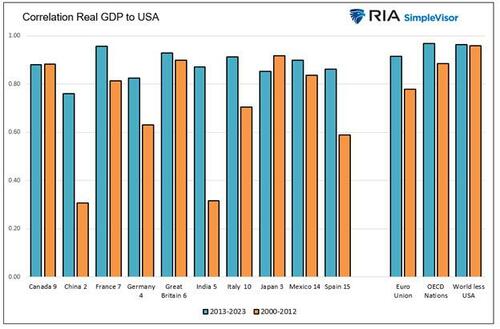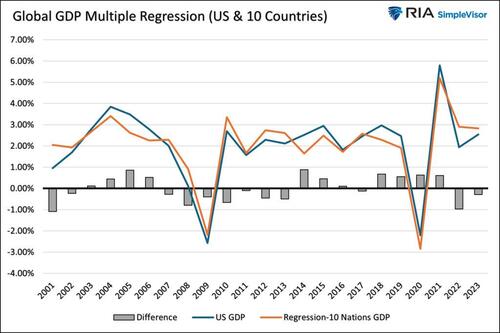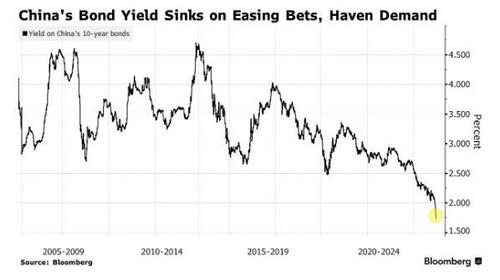Authored by Mike Shedlock via MishTalk.com,
The collapse of Germany shocks many. But I have been discussing why this was inevitable for over a decade…

Germany Is Unraveling Just When Europe Needs It Most
Bloomberg reports Germany Is Unraveling Just When Europe Needs It Most
Germany is reaching a point of no return. Business leaders know it, the people in the country feel it, but politicians haven’t come up with answers.
That has set Europe’s largest economy on a path of decline that threatens to become irreversible.
Following five years of stagnation, Germany’s economy is now 5% smaller than it would have been if the pre-pandemic growth trend had been maintained.
More worryingly, Bloomberg Economics estimates that the bulk of the shortfall will be tough to recover, due to structural blows such as the loss of cheap Russian energy and Volkswagen AG and Mercedes-Benz Group AG struggling to keep pace with China’s auto firms. The decline in national competitiveness means every household is worse off by about €2,500 ($2,600) a year.
To revive competitiveness, Germany ultimately needs to spend more. Just to catch up with other advanced economies, the country will have to increase annual investment on infrastructure and other public goods by about a third to €160 billion, according to Bloomberg Economics. That’s a rise equivalent to more than 1% of GDP.
The private sector has also held back. Expenditures on machinery are more than 9% below pre-pandemic levels. A recent survey among family-owned companies showed nearly half aren’t even planning to replace what breaks, blaming bureaucracy and unpredictable policies. That’s effectively a no-confidence vote in an economy fighting to retain its status as third-largest in the world.
Collapse of the German Government
Yesterday, I noted The German Government Collapses, Early Elections Are Coming up
Chancellor Olaf Scholz [SPD party] lost a confidence vote on Monday leaving a deeply fragmented Germany in his wake.
The only thing an election will do is shift the power from one very unstable coalition to another very unstable coalition.
I ran the coalition math. It’s pathetic.
The current Traffic Light coalition is SPD, FDP, and the Greens. FDP might not get 5 percent of the vote to stay in parliament.
All of the parties rule out an alliance with AfD (reportedly Far Right) and BSW (reportedly Far Left). Combined, that is 22-25 percent of the total.
AfD and BSW have three things in common. They are both anti-immigration, anti-NATO, and anti-Green.
A failure of the last “Grand Coalition” SPD + Union (CDU/CSU) led to the failed traffic light coalition.
Another Grand Coalition cannot possibly solve anything.
Conflicting Agendas
The Wall Street Journal has these humorous insights on the German Government Collapse.
Opinion polls show the center-right Christian Democratic Union, led by veteran conservative politician and businessman Friedrich Merz, as the likely winner of the ballot on Feb. 23. Yet the party is unlikely to command a big enough majority to govern alone or with the FDP, the other center-right party in Parliament, and will likely need to form an alliance with one or several center-left parties, forcing it to dilute its pro-business and law-and-order agenda.
“Mr. Chancellor…you had your chance. You didn’t use that chance,” Merz said in Monday’s parliamentary debate. “And it applies today, as it does on Feb. 23, 2025: You, Mr. Scholz, don’t deserve the trust!”
Merz and Scholz have different solutions in mind. The current chancellor has called for bailouts and subsidies to save jobs and prop up struggling carmakers, while Merz has floated a menu of supply-side measures such as lower taxes, less bureaucracy and steps that would make it cheaper for businesses to reach Berlin’s climate goals.
How is that Grand coalition supposed to make sense?
Without AfD there is no coalition math that makes any sense. But SPD and CDU/CSU have ruled out working with AfD.
The entire structure is nonsensical because neither Merz nor Scholz make much sense.
Merz is still wedded to nonsensical climate goals while Scholz wants to prop up struggling automakers. Sheeeh.
Shocked? I’m Not
This is all so predictable. The only thing debatably shocking is how it too so long.
Flashback April 11, 2013: Eurozone Math; One Size Fits Germany; Door Number Two
Eurozone Math
- Germany was the primary beneficiary of the ECB’s “one size fits Germany” interest rate policy.
- It is mathematically impossible for every country to be an exporter like Germany
- It is mathematically impossible for one interest rate to work when there is a multitude of fiscal policies
- It is mathematically impossible for the euro to survive without a transfer mechanism of some sort from Germany to peripheral Europe, and Germany will not allow any transfer mechanisms
- It is mathematically impossible within the realm of the euro for Spain to be more like Germany, unless Germany is less like Germany
- Germany has ruled out everything that could possibly make the eurozone work.
Euro Architects and Politicians to Blame
I do not blame Germany. I blame all the architects of the euro. I also blame all the politicians making matters worse by trying to force their will on the markets. In that sense, I do blame Merkel, but I also blame Hollande, Sarkozy, Trichet, Draghi, and everyone else involved in this mess, past or present.
One Size Fits Germany (Until it Doesn’t)
The math of the matter is Germany benefited from the Euro and from the ECB’s “one size fits Germany” interest rate policy more than any other country.
As a direct result of the unstable eurozone treaty, sovereign interest rate imbalances, Target II imbalance, and trade imbalances are out of control. Germany and the other European creditor countries are owed money that cannot be paid back.
More Like Germany
For years Germany insisted the rest of Europe should be more like Germany.
Germany skimped on infrastructure. It has pathetic internet compared to the rest of Europe.
Germany did protect old aging industries, especially diesel engines which I discussed many times.
It’s now payback time.
April 28, 2018: Bosch Announces Better Diesel Engine: Sorry Germany, Diesel is Dead
Eurointelligence: This story reminds us of the German company that developed the last generation of analogue telephone exchanges in the 1990s, hoping to fight off the relentless advance of the digital technology. It was mature and stable. And probably with some technical advantages over the then still-not-fully-developed digital technologies. But it came too late.
Eurointelligence: We find it hard to believe that this technology can be introduced early enough and in sufficient quantities to prevent diesel bans in German and other European cities. And the latter is the reason for the acute sales crisis of diesel cars, which has turned into a self-fulfilling prophecy. At a time when the US and China are developing electrical smart cars, the fate of the ultimate diesel engine looks to be the same as that of the world’s best analogue telephone exchange.
May 9, 2018: More Diesel Cheating: Germany Concocts New Ways, Audi Caught, Halts Production
Confirming a report in news weekly Der Spiegel, Germany’s transport ministry told AFP it was investigating the use of a new “illegal defeat device” in some 60,000 Audi cars, half of which are driving on German roads.
September 4, 2024: Volkswagen’s Choice: Fire Union Workers and Cut Costs, or Go Bankrupt
The unions and government leaders are howling but what must be done will be done.
Now chancellor Sholz has called for bailouts and subsidies to save jobs and prop up struggling carmakers. What a hoot.
But the German auto industry is dead. It lags the US and China on EVs, on batteries, on energy, and on basic infrastructure.
For decades Germany subsidized doomed technologies like diesel and analog phones.
The ECB’s interest rate policy “One Size Fits Germany” led to a housing bubble crisis in Spain and a near blowup of Greece.
Now Greek bonds trade at lower yields than French bonds.
Inevitable De-Industrialization of Europe
On October 12, 2018 I discussed the Inevitable De-Industrialization of Europe
Merkel has lost control. She is no longer able to protect German industry.
The European Parliament just voted to cut CO2 emissions by 40%. The European ministers voted for a 35% reduction. The latter is binding.
On June 25, 2019 I commented Rise of the Greens = Deindustrialization of Germany
Germany’s Green party killed nuclear power. German Chancellor Angela Merkel, once a strong supporter of nuclear energy, reversed course in a nod to the Greens. It did her party, nor Germany, any good.
Diesel is dead, and rightfully so, but Germany is not prepared for it. The Greens are also after coal, GMOs, and in general big business.
Deindustrialization of Germany
The Greens are going to force the deindustrialization of Germany.
- They do not want coal
- They do not want nuclear
- They do not want diesel
- The do not want Round-Up
- They do not want GMOs
- They do not want Google, Amazon, or any other large organizations
- They do want low-skill immigration
Merkel Bashes Trump
Here’s a pretty amusing flashback from May 28, 2017: Merkel Bashes Trump, Wants Europe to Control Its Own Destiny: EU Hypocrites
If the EU was really serious about “leading the way” I suggest the EU should not be big hypocrites.
I propose a good start would be to stop tariffs on solar panels, ban diesel autos, and reverse Merkel’s ban on nuclear power, and embrace rather than banning Uber.
If Europe wants to save the world, let them.
The EU Will Lag on AI for the Same Reason it Lost on Phones and EVs
Returning to more recent history, please consider my February 4, 2023 post The EU Will Lag on AI for the Same Reason it Lost on Phones and EVs
EU vs US Explained
Microsoft alone will spend over three times what Germany as a country will spend. Factor in Google, Amazon, and the US defense industry.
The EU likes to protect existing businesses. Germany cheated to protect legacy diesel engines for years.
On mundane matters like agriculture, France protects the small farm.
The EU now has lawsuits against Google, Amazon, and Microsoft. The US leads because the EU would bust up any company before it got big enough to lead on anything.
It’s the same story on artificial intelligence where Greens are hell bent on protecting rather than investing.
And heaven forbid any European company get big enough to achieve anything. The EU would bust them all up in the name of competition.
Four Fundamental Sets of Issues
-
The Euro itself
-
The EU
-
German Fiscal Policies
-
Governmental Structures
1: The Euro is fatally flawed. One interest rate for Greece, Germany, Spain, 20 nations in all, does not work. Productivity in Greece is not the same as Germany. Pensions and work rules are vastly different. There is no single eurobond like there are US Treasuries. Instead, Germany has bonds, Greece has bonds, France has bonds. The ECB rules out default. But if that was the case, there should be no differences in bond yields. Target2 Imbalances put a spotlight on the issue. That link is from 2012. I have been discussing these issue and how it relates to Germany for at least that long. To make any treaty changes all 20 nations have to agree.
2: The EU is structured such that it takes unanimous agreement to change anything not specifically allowed by treaty. A simple trade treaty with Canada took decades because one country held things up. France won’t budge on agricultural policy and a number of states including Germany won’t budge on eurobonds or fiscal debt brakes. The EU nannycrats do have energy policy authority and have made a total mess of things. The EU overregulates everything. And despite lagging the world on AI, it seems hell bent on regulating it to death. Google, Microsoft, Nvdia, Apple, and Tesla could not exist in the EU, because in the name of competition, the EU would have busted them apart before they amounted to anything.
3: Germany’s export model has crashed. It is no longer the leader in anything. German infrastructure is pathetic. Germany exported cars to China. Well guess what. China does not want those cars and the US doesn’t either. German leaders still want to protect its auto industry. Merkel destroyed Germany’s nuclear industry despite the fact that Germany is one of the safest places for nuclear plants based on fault data.
4: Review the German coalition math and conflicting goals I mentioned above. No math makes any sense. I have been writing about the failure of the Grand Coalition for a long time. That morphed into unsustainable Traffic Light Coalition that just collapsed. And now the only chance to get 50 percent is another Grand Coalition. And every country is saddled with Eurozone treaty rules as well as EU treaty rules.
5. The German constitution prohibits the types of changes needed to fix some of the problems. I discuss this in an addendum.
It’s Hopeless
The lead Bloomberg article in this post said “Europe’s largest economy on a path of decline that threatens to become irreversible.“
Threat? There is no threat. The entire Eurozone has been in an irreversible decline from the beginning because the structure of the Eurozone and EU are both fatally flawed.
Factor in country-specific issues and broken governments and it’s amazing that it took this long for as many issues to finally surface as they have in the past two years.
Even now, few have thought about the four fundamental issues that I just mentioned. And the treaties make things impossible to fix because every nation has to agree to rule changes.
The only unresolved issue is how much longer this foolish EU structure can last. I don’t know, and no one else does either, but perhaps Trump II brings it all to a head.
Addendum
I left off a 5th German issue, it’s constitutional court. The German constitution, in addition to the the Maastricht Treaty, mandates debt brakes, no debt comingling, etc.
There cannot be a eurobond until that is fixed (not that a eurobond makes any sense in the first place given the fragmented policies and work rules of various nations).
Instead, Germany is saddled with a broken target2 system in which all sovereign debt allegedly the same by treaty, but in practice isn’t, as noted by various sovereign bond yields. Implied odds of default are very different from what’s guaranteed by treaty.
Germany would like to fix EU agricultural issues but cannot because of a French veto. Every year for decades, world trade negotiations blow up because of France.
Germany (at least some political parties) would like to fix energy policy but cannot because of EU-wide rules set by the European Parliament and lack of internal agreement how.
Arguably energy is the most easiest problem to fix among those I discussed because it does not take 100 percent agreement to do so. However, addressing energy would take the European parliament and an internal German commitment to fix. Alternatively, Germany can tell the EP and European Commission President Ursula von Der Leyden (from Germany) to go to hell.
In the US, with its two-party political system, things can get only so crazy before someone comes along to fix at least some things. Trump will not be the savior his fans think, but he will fix some things.
Meanwhile, the US still has the largest, most free capital markets in the world. Europe has an unworkable, tangled mess of target2 and individual state bonds.
The center parties like SPD and CDU/CSU in Germany, and Macron’s party in France have imploded. Both governments are unworkable.
Euro apologists blame AfD, BSW, Le Pen in France, Vitor Orban in Hungary, and Geert Wilders in the Netherlands for being problems and causing unworkable governments.
In reality, all of these parties are a result, not a cause, of a fundamentally broken EU.
The only unresolved issue is how much longer this foolish EU structure can last before it implodes in a major treaty failure or currency crisis.
I don’t know, and no one else does either, but perhaps Trump II brings it all to a head.



















